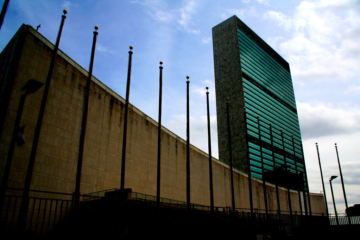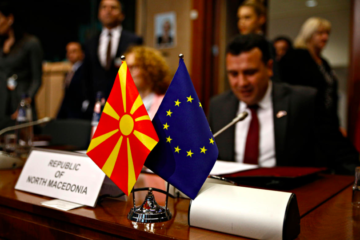The dysfunctional political system in which the student protests operate today is intertwined with the history of Albania. Forty-five years of the communist rule of Enver Hoxha and the Albanian Communist Party (ACP) since the Second World War have shaped the nature of a politics characterised by fear. Moreover, the elite of the ACP created an oligarchical social system that persists in contemporary Albanian politics. In the context of democratic transition of the 1990s post-Soviet era, student protests gained momentum. Eventually, Ramiz Alia, the then head of state and leader of the ACP, accepted calls for democratic elections. Since 1992, Albanian politics is dominated by two parties. The PS (Socialist Party of Albania) and the PD (Democratic Party of Albania), both of which have been accused of corruption and failure to provide stability and development in the country. Indeed, in Albanian politics, voting for one party or the other is not so much a reflection of an individual’s political ideology; rather, it is a calculated move to ensure the protection of one’s job and livelihood.
On paper, the current protests should not come as a surprise to analysts. In 2013, students in Tirana protested against the introduction of a new education bill that redirected public funds to private schools. Since then, there have been sporadic student protests every now and then. Adding to that, Prime Minister Rama has not held his campaign promise that he would keep the percentage of the state budget dedicated to education at five percent. Also, a 2014 law eroded the autonomy of the universities by providing the government with more control over the allocation of its budget. It has been argued that the protests today are as much an attack against Rama’s tenure as they are a response to the rising fees. Last week, the rising fees were finally met by protests of the extent of the student protests of the 1990s.
On the talk show Opinion with Blendi Fevziu, one student explains how she works two jobs of over 17 hours to pay off the tuition fees. The progressive increase of university fees is unbearable for the majority of the population. The protesters complain that the universities charge anywhere from 400 euros to 2,560 euros annually, a large amount for the average 350 euro earnings of an Albanian family. For comparison, a master’s degree of two years costs around 1000 pounds in Albania while in Kosovo each semester costs only about 50 euros.
Another individual argues that students might have accepted the increasing fees if the education they received was worth their money. Yet, the state of public higher education institutions is dismal. One biology student explained that at his university there are no labs in which to perform any practical tests, and another studying computer science states that his whole cohort shares only one computer. Compounding these inadequacies is the value of the degree students are receiving upon completing their studies. The combination of higher fees for university without the corresponding increase in the employability of graduating students is a cause for concern. Youth unemployment is at 23.2%, although this is down 2.8% from last year.
From the outset, Rama has incompetently handled the government response to the protestors, initially calling the demonstrators “failures.” However, throughout the week, Rama has continuously encouraged negotiations. On Top Show with the presenter Arba Dudushi, Rama reaffirmed that the eight points requested by the students could be fulfilled provided the students agreed to negotiate. Indeed, it is claimed that one of the eight points has already been met as three million euros have been put aside for the reconstruction of student accommodation.
Yet the student movement has increasingly adopted the slogan of “No negotiations.” On the show Opinion, the journalist Prez Zogaj explains that there is no need for negotiations. If, as Rama says, the points can be met, then the government must act. Indeed, the protestors start to see Rama’s calls for negotiation as a smokescreen to prolong the situation and reduce the momentum of the movement.

The reluctance to negotiate with the government has led to accusations that the movement has political goals and protests continue to overturn the sitting government. The protesters themselves insist that the movement has no political objectives. However, Rama has initiated an investigation into the organisers and any links they may have with members of parliament. Indeed, Lulzim Basha, the leader of the opposition party, believes that these are the critical moments of a popular revolt that is about more than just university fees. The capacity of the student protesters to create an umbrella movement, similar to the protests in 1990, under which many can unite has shown some sparks. The miners in the municipality of Bulqize are protesting over increased taxes and unemployment in solidarity with the students. Protesters in the area of Astir rise up against government projects. Likewise, citizens of Tirana are seen on video encouraging the student protesters despite being trapped in traffic. Yet whether this represents the goals of the student protests remains controversial.
The next few days will be crucial. Rama’s unwillingness to initiate reforms without negotiations and the students’ unwillingness to approach the negotiating table until concrete actions are taken creates a cycle of non-negotiation fuelling the protests from which both parties must escape. This explains why the protest actually persists as both parties are unwilling to make the necessary commitments towards a resolution of the core issues. The students have to put their trust in some form of leadership to carry out negotiations. Simultaneously, those in government claiming to represent the interests of the students must show good will by implementing reforms. These reforms must not benefit any individual or political group but the students who are the future of Albania.
Most importantly, the protesters of today must not take the same path as the protesters of the 1990s. The politicisation of that movement resulted in the absorption of its representatives into the state. Those representatives ended up becoming politicians and businessmen while the state of the universities and the fate of the majority of students were neglected. The movement today is the culmination of the democratic movement that began in the 1990s. There needs to be representation for the students and the professors in the decisions that the government and the heads of the universities make. Indeed, the protests initiated by these students have shown that a revolutionary fire still exists in the hearts of Albanians.


